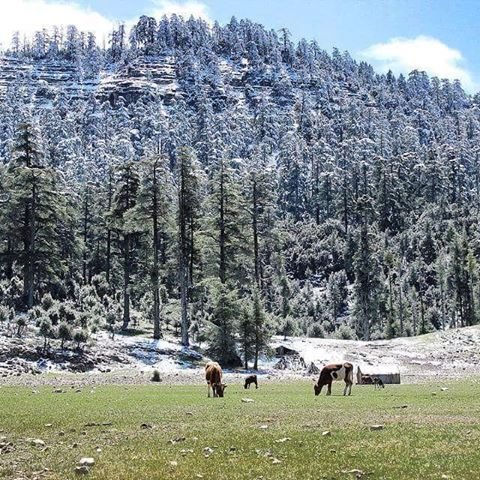Khenifra.. The incredible town forgotten in the middle of Morocco
Hi everyone!
Today I'm here to talk about a very beautiful place which is unfortunately unknown by the majority of you! So that's why I decided to share of you the story of a beautiful town.. The story of Khenifra. Khenifra is the place where I was born.. its a warm town probably because of the kindness of people living in it.. also khenifra has the most magical views of nature you'll be totally sharmed.. its like the all beauty of nature has decide to reunite in it.
The province of Khénifra is one of five subdivisions of the region Béni Mellal-Khénifra, Morocco
Geography
the city Khénifra integrates both in the High Atlas and the central plateau, which explains its rugged terrain where alternate mountains and plateaus whose altitude is variable (relief in floor) which characteristics typical of the Middle Atlas:
1 floor collieen (800 m)
2 Subatlassian (mountain range from 800 m to 1,600 m)
3 Floor, atlassian (from 1,660 m to 2,800 m)
Forest
The forest of Khénifra, in particular Ajdir Izayane by its diversity of its richness (hydrological, faunal and floristic) deserves a very particular attention, thus an awareness with regard to this inheritance which risks one day to disappear. A population awareness program must be imposed in order to put an end to the irrational exploitation of the forest.
The forest of the Middle Atlas and particularly in the region of Khénifra occupies a privileged place in biodiversity of its fauna and flora.
The Middle Atlas appears as a mountain range not populated by man. In fact, with the exception of Taza in the North and Khenifra in the South, only small urban centers have settled on the outskirts of the massif.
This massif is exceptional by the diversity of its fauna, the exuberance of its flora, and the beauty of its rocks and its geological sites. Due to its location and the physical characteristics of its environment, the Middle Atlas region is rich in renewable natural resources: aquatic, edaphic, floristic, faunistic, forest. Indeed, it constitutes a wetland (water tower of Morocco) favorable to the influx of the birds coming from European continent seen the geographical situation of Morocco which constitutes a migratory passage of the birds (corridor of Gibraltar).
The soils are the most advanced, the most diversified and the richest, but also, locally, among the most eroded; the flora and fauna are very rich, and they contain a large number of endemic species, rare or very remarkable; vegetation is very diverse; the phytocenoses are lush and offer the most important forest potential of Morocco; except for arid and saharan areas, all types of natural Moroccan ecosystems are represented.
However, many plant and animal species have disappeared from this region; others are threatened with extinction or have become very rare; natural ecosystems, especially foresters among them, are under strong anthropo- zoogenic pressure; some have been wiped out, others are dysfunctional in addition to the population dynamics which is added as a negative factor for the ecosystem.

Zayane culture
The Zayanes are a Berber tribe from the region of Khénifra, in the Middle Atlas, in Morocco and Italy, who lived in the mountains, their living space which goes from the big cedar of Ajdir to Boujaad border of Arabic-speaking tribes. The Zayane tribe is nomadic moving twice a year: in winter towards Azaghar where the climatic conditions are mild, in summer towards the Jbel. The Zayan tribes are known for their warlike tenacity especially during the colonization under the leadership of Mouha or Hammou Zayani who had put the settlers in trouble during the conquest of Khénifra. Despite the French defeat of 13 November 1914 at the battle of Elhri where the French army was humiliated, the strategists of the colonization were determined not to give up the fight against the Zayanis which constitute a stronghold of the rebellion.
The Zayane culture is part of the great Amazighe culture, with its specificities, which distinguish it from other cultures, the most concrete example of Amazigh culture (Berber) is the Ait Hdidou (great tribe of Ait Yaflmane) of Imilchil where is organized annually a great festival of a typical cultural dimension proper to Amazighs.
Although they were among the first inhabitants of Morocco from the north and east, and since the Neolithic era, the Berbers of the Middle Atlas lived in a very isolated, closed and hermetic community, contrary to the thesis of European explorers which suppose the homogeneity between the tribes. Now the tribe constitutes an entity with its specified without obvious relations even with the neighboring tribes. Talking about "Tamazgha" (Maghreb territory) as a purely Berber geographic area remains a taboo subject.
In the Middle Atlas and elsewhere the Berbers have never been confederated. Despite various Phoenician incursions, Roman, vandal, Arab, .... These populations lived isolated without contact with the civilizations having conquered the Maghreb.
The most representative tribes of the Zayanes are Ait Bouhadou, Imrabten, Ibouhssousen and Ait Lahsen or Said which represent 65% of the Zayan tribes.
In the next article I will talk to you about some places to visit in khenifra - morocco .
Good travel
Thanks brother
Good bro
Thanks brother
Nice
Thanks brother
Bravo
Mercii frere
Good
Thanks brother
Nice
Thanks brother
good job bro
Thanks broo
Good job
تانكس برووو
Goood post
Thanks brooo
Congratulations @riearrie! You have completed some achievement on Steemit and have been rewarded with new badge(s) :
Click on any badge to view your own Board of Honor on SteemitBoard.
For more information about SteemitBoard, click here
If you no longer want to receive notifications, reply to this comment with the word
STOP